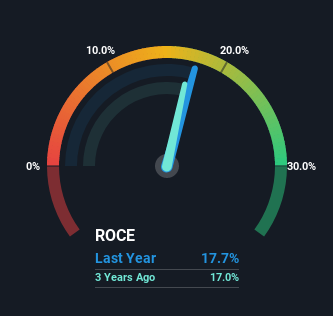Returns Are Gaining Momentum At Billion Industrial Holdings (HKG:2299)

Finding a business that has the potential to grow substantially is not easy, but it is possible if we look at a few key financial metrics. Ideally, a business will show two trends; firstly a growing return on capital employed (ROCE) and secondly, an increasing amount of capital employed. Basically this means that a company has profitable initiatives that it can continue to reinvest in, which is a trait of a compounding machine. With that in mind, we've noticed some promising trends at Billion Industrial Holdings (HKG:2299) so let's look a bit deeper.
Understanding Return On Capital Employed (ROCE)
If you haven't worked with ROCE before, it measures the 'return' (pre-tax profit) a company generates from capital employed in its business. Analysts use this formula to calculate it for Billion Industrial Holdings:
Return on Capital Employed = Earnings Before Interest and Tax (EBIT) ÷ (Total Assets - Current Liabilities)
0.18 = CN¥1.9b ÷ (CN¥27b - CN¥16b) (Based on the trailing twelve months to June 2022).
Therefore, Billion Industrial Holdings has an ROCE of 18%. On its own, that's a standard return, however it's much better than the 9.4% generated by the Luxury industry.
See our latest analysis for Billion Industrial Holdings

While the past is not representative of the future, it can be helpful to know how a company has performed historically, which is why we have this chart above. If you're interested in investigating Billion Industrial Holdings' past further, check out this free graph of past earnings, revenue and cash flow.
How Are Returns Trending?
Investors would be pleased with what's happening at Billion Industrial Holdings. Over the last five years, returns on capital employed have risen substantially to 18%. Basically the business is earning more per dollar of capital invested and in addition to that, 91% more capital is being employed now too. So we're very much inspired by what we're seeing at Billion Industrial Holdings thanks to its ability to profitably reinvest capital.
On a side note, we noticed that the improvement in ROCE appears to be partly fueled by an increase in current liabilities. The current liabilities has increased to 61% of total assets, so the business is now more funded by the likes of its suppliers or short-term creditors. And with current liabilities at those levels, that's pretty high.
What We Can Learn From Billion Industrial Holdings' ROCE
To sum it up, Billion Industrial Holdings has proven it can reinvest in the business and generate higher returns on that capital employed, which is terrific. Given the stock has declined 11% in the last five years, this could be a good investment if the valuation and other metrics are also appealing. That being the case, research into the company's current valuation metrics and future prospects seems fitting.
While Billion Industrial Holdings looks impressive, no company is worth an infinite price. The intrinsic value infographic in our free research report helps visualize whether 2299 is currently trading for a fair price.
While Billion Industrial Holdings may not currently earn the highest returns, we've compiled a list of companies that currently earn more than 25% return on equity. Check out this free list here.
Valuation is complex, but we're here to simplify it.
Discover if Billion Industrial Holdings might be undervalued or overvalued with our detailed analysis, featuring fair value estimates, potential risks, dividends, insider trades, and its financial condition.
Access Free AnalysisHave feedback on this article? Concerned about the content? Get in touch with us directly. Alternatively, email editorial-team (at) simplywallst.com.
This article by Simply Wall St is general in nature. We provide commentary based on historical data and analyst forecasts only using an unbiased methodology and our articles are not intended to be financial advice. It does not constitute a recommendation to buy or sell any stock, and does not take account of your objectives, or your financial situation. We aim to bring you long-term focused analysis driven by fundamental data. Note that our analysis may not factor in the latest price-sensitive company announcements or qualitative material. Simply Wall St has no position in any stocks mentioned.
About SEHK:2299
Billion Industrial Holdings
Develops, manufactures, and sells polyester filament yarns products, polyester products, polyester industrial yarns products, and ES fiber products in the People’s Republic of China and internationally.
Excellent balance sheet with proven track record.
Market Insights
Community Narratives



